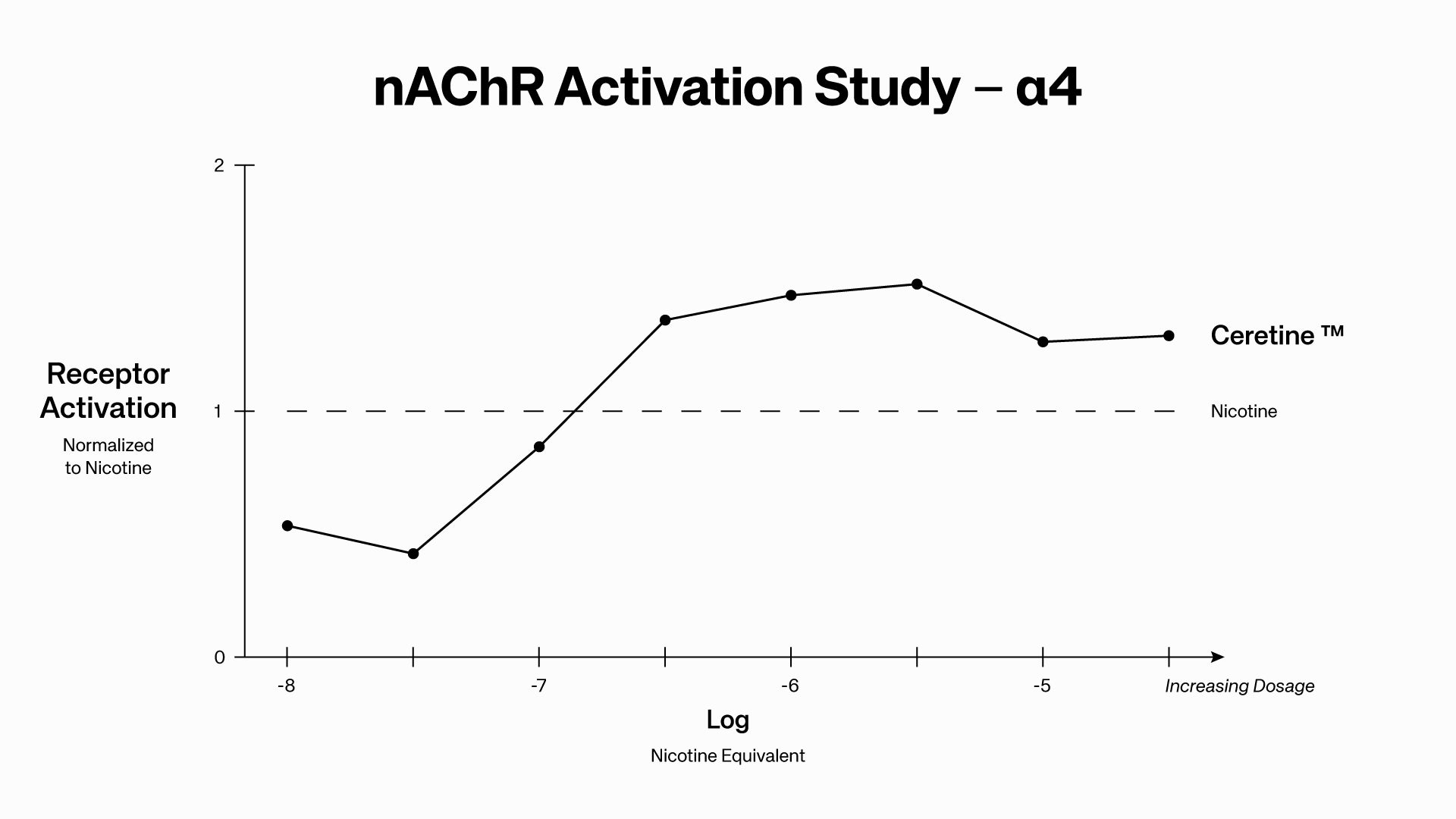
Ceretine™: The Superior Nicotine Alternative
Everything you need to know about Ceretine™
- Deep Dive
- Deep Dive
- Deep Dive
- Deep Dive
- Deep Dive
- Deep Dive
What is Ceretine™?
Ceretine is a proprietary, patented ingredient designed to deliver the same satisfaction as nicotine with fewer downsides. Ceretine™ is a synthetic alkaloid which is similar in structure to nicotine, yet chemically distinct. Ceretine works on the same mechanism of action as nicotine. More specifically, Ceretine™ binds to nicotinic-acetycholine receptors (nAChRs) in the brain - thus promoting higher levels of dopamine and acetylcholine in the brain. This mechanism promotes feelings of positive mood, focus, and motivation.
How was Ceretine™ developed?
The story behind Ceretine™ begins in the early 1980s. Big Tobacco was in the midst of a royal-spanking from the health authorities for lying about the health consequences of smoking. There was concern among these companies that nicotine might get banned altogether in the US, so they set out to develop better alternatives to nicotine . Scientists at these companies synthesized more than 20 different ‘nicotine-alternatives’ - some of which had very promising research behind them.
As we all know, nicotine was not banned in the US, so for the most part Big Tobacco did their best to bury the evidence around these nicotine alternatives. We believe they did this because they might have actually found compounds that are better than nicotine, and potentially less addictive.
40 years later, our scientists picked up where these folks left off. We identified the most promising of these compounds and conducted our own clinical trials to verify safety and efficacy. Then of course, we had to try the product ourselves. We ran more 15 different test-batches with multiple manufacturing partners to develop our first product - all along the way consulting with our Scientific Advisor Board and sharing our prototypes with fellow high-performing nicotine users to compare effects.
What we have created today is a product that is perfectly tailored to the consumer that uses nicotine to be more productive and energized, but doesn’t want to be left feeling anxious and drained after using their pouches. In conjuction with other functional ingredients like L-Theanine, we think you’ll feel better during and after using our pouches. In the long run, our goal is to prove that Ceretine™ is measurably better than nicotine on multiple dimensions, and we are purusing a robust clinical strategy to validate this

How is Ceretine™ made?
Ceretine™ is produced through a proprietary process of modifications to nicotinic acids (B-vitamins). It is produced in a FDA-registered facility in the United States. This facility is CGMP, and ISO-9001 certified. There are zero tobacco products or derivatives involved in this process. Ceretine™ is made in partnership with Bonguard Naturals.
Clinical Validation
Ceretine™ has gone through rigorous testing over the last two years, with even more studies planned for the near future. We have performed toxicity studies in vitro and in vivo to confirm that Ceretine™ is not carcinogenic, nor mutagenic, and has a similar toxicity profile to that of nicotine.
We have also performed ‘receptor-binding affinity’ studies to measure how exactly Ceretine™ interacts with nAChRs. These studies show that, in aggregate, Ceretine™ has an extremely similar binding affinity to that of nicotine, but interestingly, binds less effectively to the α6 AChR (pronounced ‘Alpha 6’). This specific receptor is believed to play a signifcant role in nicotine dependence.
Study design
We investigated the relative nAChR activation potential of Nicotinic α4, α3, and α6 using an agonist Fluorometric Imaging Plate Reader (FLIPR) assay.
nAChr Activation Study - α4
Nicotinic α4 receptors have high affinity for nicotine and account for >90% of nicotine binding to brain tissue.

nAChR Activation Study - α3
Nicotinic α3 receptors are involved in nicotine reward and physical withdrawal.

nACHr Activation Study - α6
Nicotinic α6 receptors are involved in nicotine-stimulated dopamine release and may play a role in nicotine dependence.

Planned Studies for 2025:
- Dissolution
- In vitro Tox (replication study)
- In vivo Pharmokinetics (mice)
- In vivo Short-term memory, processing speed, etc. (humans)
- In vivo Blood Pressure (humans)
FAQs
Do I need to be 21 to buy Sett pouches?
Is Ceretine addictive?
Is Ceretine considered a tobacco product?
Do you plan to offer other form-factors?

